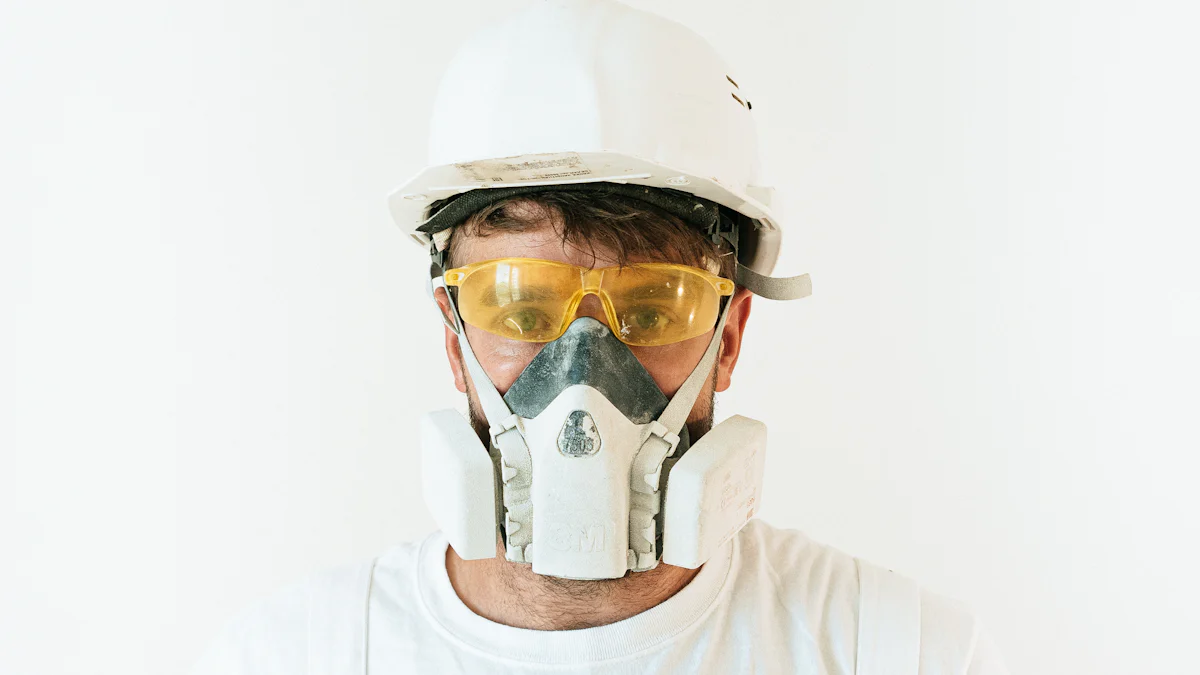
Electrical work can be dangerous, and you know how critical it is to stay protected with electrical safety PPE. Every year, approximately 4,000 workplace electrocutions and 30,000 nonfatal electrical injuries occur. These incidents often result in significant costs, ranging from $1 to $4 million for treating nonfatal injuries. That’s why electrical safety PPE is a must-have for anyone working around electrical hazards.
In 2025, updated standards like NFPA 70E and OSHA regulations emphasize proactive safety measures. The NFPA 70E revisions focus on identifying risks and using the hierarchy of controls to create safer environments. These updates make it clear that both employers and workers share the responsibility for meeting electrical safety requirements. By using the right electrical safety PPE, you can reduce risks and ensure compliance with these standards.
Key Takeaways
Electrical safety PPE keeps you safe from shocks and burns. Always check for risks before starting any job.
New rules in 2025 say PPE must handle arc flashes. Make sure your gear includes arc suits and special gloves.
Always inspect your PPE. Look for any damage before using it to stay safe and follow OSHA rules.
Training is important to use PPE correctly. Teach workers often about using gear and staying aware of dangers.
Use other safety steps first. Try fixing hazards with tools or rules, and use PPE only if needed.
Updated Standards and Regulations for 2025

Overview of NFPA 70E Updates
Key changes in arc flash protection requirements
The NFPA 70E updates for 2025 bring significant improvements to arc flash safety. These changes focus on better hazard identification and risk assessment. Here’s what you need to know:
New guidelines require additional precautions when incident energy exceeds 40 cal/cm². This includes verifying the absence of voltage before work begins.
A new Informational Note emphasizes wearing electrical personal protection equipment (PPE) even when equipment covers are secured. This ensures you’re protected from unexpected arc flash incidents.
These updates highlight the importance of proactive measures to reduce risks and improve electrical safety standards.
Updates to risk assessment procedures
Risk assessment procedures have also been refined. The updated NFPA 70E now places greater emphasis on identifying potential hazards and evaluating the effectiveness of existing controls. You’ll need to document these assessments thoroughly and ensure they align with the hierarchy of controls. This approach helps you create a safer work environment by addressing risks at their source.
OSHA Requirements for Electrical Safety PPE
PPE standards under OSHA 1910 Subpart I
OSHA regulations for 2025 reinforce the importance of selecting the right PPE for electrical hazards. Employers must assess the workplace for risks and provide appropriate electrical PPE for each task. Key requirements include:
All PPE must be arc-rated (AR). Flame-resistant clothing alone no longer meets the standards.
Essential items include arc flash suits, voltage-rated gloves, insulated tools, and safety shoes with non-conductive soles.
Hard hats with arc-rated face protection, safety glasses, and hearing protection are also mandatory.
These OSHA standards ensure that workers are equipped with the best tools to handle electrical hazards safely.
Emphasis on hazard communication and training
OSHA’s 2025 updates also stress the importance of hazard communication and training. Employers must:
Requirement | Description |
|---|---|
Labeling | Ensure labels for hazardous chemicals are accurate and up-to-date. |
Safety Data Sheets | Maintain updated Safety Data Sheets (SDS) for all hazardous materials. |
Employee Training | Provide training on updated hazards and safety measures. |
By following these guidelines, you can ensure your team understands the risks and knows how to use PPE effectively.
Industry-Specific Standards
Standards for utilities and manufacturing industries
Utilities and manufacturing industries face unique challenges when it comes to electrical safety. To address these, industry-specific standards require:
A clear understanding of specific hazards and PPE limitations.
Regular maintenance and inspection of PPE to ensure reliability.
Employees working with high-voltage equipment must wear arc-rated clothing to protect against heat and debris from arc flash incidents. Specialized garments like Nomex® and Kevlar® provide additional protection for these high-risk environments.
Alignment with international standards like IEC 61482
The 2025 updates also align with international standards such as IEC 61482. This ensures consistency in electrical safety practices worldwide. By adhering to these regulations, you can maintain compliance while protecting workers from arc flash incidents and other electrical hazards.
Key Requirements for Electrical Safety PPE
Hazard Assessment and PPE Selection
Identifying electrical hazards in the workplace
When working around electricity, you need to identify potential hazards to stay safe. Start by looking for risks like electric shocks, arc flashes, burns, and exposure to flying debris or chemicals. Pay attention to the voltage levels involved in your tasks. Higher voltages mean greater risks, so your PPE must match the job. Familiarize yourself with electrical safety standards like OSHA and ANSI to ensure compliance. Also, consider the size and fit of your PPE. Ill-fitting gear can compromise your protection.
Determining the appropriate PPE for each hazard
Choosing the right PPE depends on the specific hazards you face. For shock hazards, evaluate the voltage exposure and select PPE rated for that level. For arc flash safety, calculate the incident energy and pick arc flash PPE with an arc rating that meets or exceeds the energy level. Always inspect your gear before use to ensure it’s in good condition. Reliable PPE is your first line of defense against electrical hazards.
Arc-Rated PPE Requirements
Minimum arc rating for different hazard levels
Arc-rated clothing is essential for protecting against arc flashes. The minimum arc rating depends on the hazard level:
Category | Minimum Arc Rating | PPE Items Required |
|---|---|---|
1 | 4 cal/cm² | Coverall, hard hat, safety glasses, rubber-insulating gloves, leather footwear |
2 | 8 cal/cm² | All items in Category 1 + arc-rated balaclava and jacket |
3 | 25 cal/cm² | All items in Category 1 + arc-rated jacket, pants, and hood |
4 | 40 cal/cm² | All items in Category 3, arc-rated to 40 cal/cm² |
Types of arc-rated clothing and equipment
Flame-resistant clothing is a must-have for arc flash safety. It shields you from extreme heat and flames, reducing the risk of burns. Common options include arc flash suits, which combine jackets, pants, and hoods for full-body protection. These items are made from non-conductive materials to keep you safe.
Testing and Certification Standards
Frequency of PPE testing and recertification
Your electrical PPE needs regular testing to ensure it works properly. Inspect it before every use and when you first receive it. While specific intervals for testing vary, following manufacturer recommendations is key. Regular inspections help you catch wear and tear early, so you can replace damaged items before they fail.
Recognized testing organizations and certifications
When buying PPE, look for certifications from trusted organizations like ANSI. These certifications confirm that the gear meets minimum PPE standards for electrical safety. Choosing certified equipment ensures you’re getting reliable protection that complies with electrical safety standards.
Guidelines for Selecting Appropriate PPE

Hierarchy of Controls and PPE Selection
Prioritizing engineering and administrative controls
When it comes to electrical safety, you should always start with the hierarchy of controls. This approach prioritizes eliminating hazards at their source. For example, you might replace outdated equipment or install barriers to reduce exposure. Engineering controls, like insulation or grounding systems, are next in line. Administrative controls, such as safety protocols and training, also play a key role. Personal protective equipment (PPE) comes into play only when these measures can’t fully eliminate risks.
Always ensure your PPE is rated for the specific risks you face, like arc flash incident energy levels.
When and how to rely on PPE as a last line of defense
You should never rely solely on PPE. While it protects you, it doesn’t eliminate hazards. Always follow the hierarchy of controls, starting with the most effective measures. For instance, if you’re working near high-voltage equipment, ensure proper lockout/tagout procedures are in place before donning your PPE. Remember, PPE is there to minimize harm when other controls fall short.
Types of Electrical Safety PPE
Insulated gloves and tools
Insulated gloves and tools are essential for protecting your hands and arms from electric shocks. Voltage-rated gloves are specifically designed to handle different voltage levels. Pair them with rubber lineman gloves for added safety. Insulating tools, like screwdrivers and pliers, provide an extra layer of protection when working on live circuits.
Face shields, helmets, and protective clothing
Your head and face need protection too. Hard hats with electrical insulation properties shield you from falling objects and electrical contact. Face shields guard against arc flashes, while flame-resistant clothing and arc flash PPE protect your body from burns. These items are non-negotiable when working in high-risk environments.
Matching PPE to Job Tasks
PPE for low-voltage vs. high-voltage work
Different tasks require different PPE. For low-voltage work, you might need basic arc-rated clothing and insulated tools. High-voltage tasks demand more robust protection, like full-body arc flash suits and voltage-rated gloves. Always assess the voltage levels and choose PPE that matches the job.
Specialized PPE for unique environments
Some environments call for specialized PPE. For instance, if you’re working in areas with molten metal risks, you’ll need gear tested for heat resistance. Fluorescent materials and reflective strips improve visibility in low-light conditions. Always review the specific hazards of your workplace to select the right equipment.
Tip: Properly fitting PPE ensures maximum protection and comfort. Don’t overlook this detail when selecting your gear.
Maintenance and Inspection Protocols

Regular Inspection Guidelines
Identifying wear and tear or defects
Regular inspections are crucial for keeping your electrical safety PPE in top condition. Damaged or worn-out gear can’t protect you properly. Here’s what you should do:
Check all PPE for signs of damage, like cuts, tears, or fraying.
Look for discoloration or material deterioration that might weaken its protective properties.
Inspect gloves for punctures and helmets for cracks or dents.
Always inspect PPE before its first use and before every task.
Replace any defective items immediately to avoid unnecessary risks.
By staying vigilant, you can ensure your PPE meets OSHA standards and keeps you safe.
Inspection checklists for common PPE items
Using a checklist simplifies inspections and ensures nothing gets overlooked. Here’s a quick guide:
PPE Item | Key Aspects to Inspect |
|---|---|
Head Protection | Check hard hats and helmets for cracks, dents, and proper fit. |
Eye Protection | Inspect safety goggles, face shields, and safety glasses for clarity and adequate coverage. |
Hearing Protection | Ensure that earplugs and earmuffs are available and utilized in noisy environments. |
Respiratory Protection | Verify the condition of respirators and masks to protect against airborne contaminants. |
Hand Protection | Check gloves for tears, punctures, and proper sizing. |
Foot Protection | Inspect safety boots and shoes for wear, slip resistance, and toe protection. |
High Visibility Clothing | Assess the condition of reflective vests and clothing for visibility in low-light conditions. |
Fall Protection | Ensure that harnesses, lanyards, and lifelines are in good condition and used when required. |
Cleaning and Storage Best Practices
Proper cleaning methods for arc-rated clothing
Keeping your arc-rated clothing clean helps maintain its protective properties. Follow these tips:
Use mild detergent and warm water for washing. Avoid bleach or harsh chemicals.
Hand-wash lightly soiled garments in lukewarm water. For heavy soiling, machine-wash on a gentle cycle.
Hang garments to dry. Avoid tumble drying, as it can damage the fabric.
Regularly inspect your clothing for damage and repair or replace it as needed.
Proper cleaning ensures your gear stays effective and compliant with electrical safety standards.
Storage conditions to maintain PPE integrity
Storing your PPE correctly is just as important as cleaning it. Always:
Keep items in a cool, dry place to avoid heat and humidity damage.
Protect safety glasses and face shields from dust and scratches.
Store rubber items, like insulating gloves, away from direct sunlight.
Avoid exposure to chemicals that could degrade or make your PPE flammable.
Good storage practices extend the life of your equipment and keep it ready for use.
Testing and Replacement Intervals
When to replace PPE based on wear or testing results
Knowing when to replace your PPE is vital for safety. Here are some general guidelines:
Replace hard hats with cracks, dents, or after any impact.
Inspect gloves for fraying, discoloration, or worn spots. Replace them if you notice any issues.
Check safety footwear for cracks or material separation. Replace them if they’re compromised.
Inspect fall protection systems before each use. Replace them if you see signs of wear or damage.
Frequent checks ensure your PPE remains reliable and effective.
Manufacturer recommendations vs. regulatory requirements
Manufacturers and OSHA regulations both provide guidance on PPE maintenance. Manufacturers often recommend replacing hard hat suspensions every 12 months and the shell every 2-5 years, depending on usage. OSHA standards require inspections before each use but don’t specify exact replacement timelines. Following both ensures your PPE stays compliant and functional.
Tip: Always follow the manufacturer’s instructions for cleaning, storage, and replacement. This helps you meet OSHA standards and prolongs the life of your PPE.
Training and Compliance

OSHA Training Requirements
Frequency and scope of PPE training
You can’t expect workers to use electrical safety PPE effectively without proper training. OSHA requires you to provide training whenever new PPE is introduced or when workplace hazards change. Regular refresher courses are also essential to keep everyone up to date. These sessions should cover the correct use, care, and maintenance of PPE, as well as the specific hazards workers might face. By ensuring your team knows how to handle their gear, you’re not just meeting OSHA standards—you’re actively reducing risks.
Documentation and record-keeping for compliance
Keeping accurate records is a big part of staying compliant with OSHA standards. Here’s what you should document:
PPE requests: Record when workers request specific items.
Issuing records: Track when PPE is issued to ensure traceability.
PPE registers: Maintain a log of inventory and usage to identify when replacements or additional training are needed.
You should also verify that PPE is being used correctly, check its condition regularly, and ensure it’s always available. These practices help you stay organized and compliant.
Understanding PPE Limitations
Educating workers on what PPE can and cannot do
It’s important to teach your team that PPE isn’t foolproof. While it’s designed to protect against electrical hazards, it’s not a substitute for safe work practices. For example, insulating gloves shield against electric shocks, but they won’t prevent accidents caused by poor procedures. Make sure your workers understand the limitations of their gear.
Note: Wearing PPE should always be viewed as the last line of defense. It’s there to minimize harm when other controls fail, not to eliminate risks entirely.
Reinforcing the importance of proper usage
Training isn’t a one-and-done deal. Regular sessions help reinforce the importance of using PPE correctly. Include PPE training as part of your safety program to keep everyone informed about updates and best practices. This also gives you a chance to review how effective your current measures are.
Building a Safety Culture
Encouraging worker participation in safety programs
Your workers are your best resource for identifying hazards. Involve them in every step of your safety program. When you include their input, you create a sense of ownership that boosts engagement. Workers often know the risks better than anyone else, so their insights can make your program more effective.
Leadership’s role in promoting PPE compliance
Leadership sets the tone for safety. As a leader, you should establish clear expectations and communicate them through comprehensive safety policies. Provide the resources and training your team needs to stay safe. Encourage open communication so workers feel comfortable reporting concerns. Recognize and reward safe behaviors to reinforce compliance. Proactive monitoring and evaluation also help you identify areas for improvement.
Tip: A strong safety culture starts at the top. When leaders prioritize safety, it inspires everyone else to do the same.
Staying compliant with the updated electrical safety PPE standards in 2025 isn’t just about following rules—it’s about keeping your team safe. You should focus on hazard assessments, choosing the right gear, and maintaining it regularly. Don’t forget to train your workers so they know how to use their PPE effectively. Resources like the nfpa guidelines and OSHA regulations can help you stay on track. By prioritizing safety, you create a workplace where everyone feels protected and confident.
FAQ
What is the most important factor when selecting electrical safety PPE?
The most important factor is matching the PPE to the specific hazard. For example, if you’re working with high-voltage equipment, choose arc-rated clothing and voltage-rated gloves. Always assess the risks first.
How often should electrical PPE be inspected?
Inspect your PPE before every use. Look for wear, tears, or damage that could compromise safety. Regular inspections ensure your gear stays reliable and compliant with OSHA standards.
Can I wash arc-rated clothing at home?
Yes, but follow the care instructions. Use mild detergent and avoid bleach or fabric softeners. Machine-wash on a gentle cycle and hang to dry. Proper cleaning helps maintain the protective properties of your gear.
What happens if my PPE doesn’t fit properly?
Ill-fitting PPE can reduce protection and increase risks. For example, loose gloves might expose your skin, while tight clothing could restrict movement. Always choose gear that fits well to ensure maximum safety and comfort.
Are there specific certifications I should look for when buying PPE?
Yes, look for certifications from trusted organizations like ANSI or IEC. These ensure the PPE meets safety standards for electrical hazards. Certified gear gives you confidence that you’re using reliable and compliant equipment.
Tip: Always check the manufacturer’s label for certifications and ratings before purchasing PPE.
See Also
Selecting The Ideal Universal Absorbent Socks For Work Environments
Useful Tips For Users Of Oil-Only Absorbent Socks

